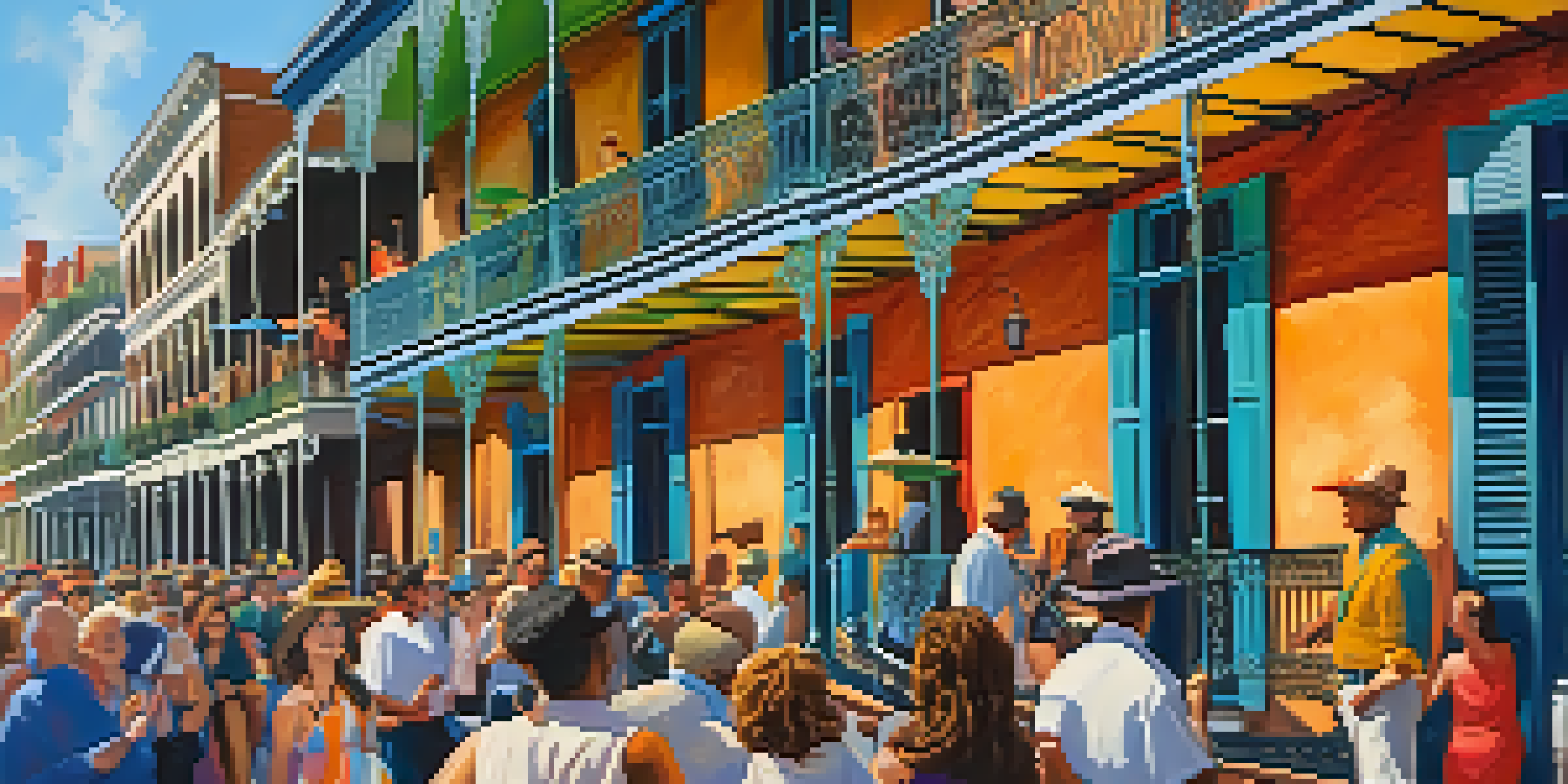Louisiana's Historic Cities: New Orleans and Beyond

New Orleans: The Heartbeat of Louisiana's Culture
New Orleans is often considered the crown jewel of Louisiana, brimming with vibrant culture and rich history. Known for its lively music scene, mouthwatering cuisine, and unique festivals, the city captivates visitors from around the world. From the soulful sounds of jazz in the French Quarter to the colorful parades of Mardi Gras, there's a spirit here that’s hard to resist.
New Orleans is a city that has a soul, and its music, food, and culture are all part of that soul.
Walking through the historic streets of New Orleans is like stepping back in time. The architecture reflects a blend of French, Spanish, and Creole influences, creating a visual feast for the eyes. Landmarks like St. Louis Cathedral and the iconic wrought-iron balconies tell stories of a bygone era, inviting exploration and discovery.
Beyond the surface, New Orleans is a city of resilience and innovation. Its ability to embrace change while honoring its traditions showcases the strength of its community. This unique combination makes New Orleans not just a destination, but a living, breathing experience that resonates with everyone who visits.
The French Quarter: A Historical Milestone
The French Quarter, or Vieux Carré, is the oldest neighborhood in New Orleans, dating back to 1718. It’s a vibrant tapestry of history, where every building has a story to tell. This area is known for its lively atmosphere, with street performers and artists adding to its charm, making it a must-visit for anyone wanting to experience the essence of the city.

As you stroll through the narrow streets, you'll encounter iconic sites such as Jackson Square and the Cabildo, which offer insights into the city's storied past. The aroma of beignets from Café du Monde wafts through the air, beckoning visitors to indulge in local delicacies. Each corner reveals a new surprise, from hidden courtyards to bustling markets.
New Orleans: Cultural Epicenter
New Orleans is a vibrant city known for its rich culture, lively music scene, and unique festivals that attract visitors worldwide.
The French Quarter also serves as a cultural melting pot, showcasing a rich blend of music, art, and cuisine. Local musicians often perform in the streets, infusing the area with the sounds of jazz, blues, and zydeco. This vibrant energy makes the French Quarter not just a place to visit, but an experience to immerse oneself in.
Baton Rouge: The Capital Steeped in History
Baton Rouge, the state capital, is a city rich in history and political significance. It's home to the Louisiana State Capitol, the tallest capitol building in the United States, which offers stunning views of the Mississippi River. Visitors can explore the building's beautiful gardens and learn about the state's history through various exhibits.
The past is never dead. It's not even past.
The city’s Historic District showcases a variety of architectural styles, from antebellum homes to modern designs. Among these is the Old State Capitol, a Gothic architectural gem that now serves as a museum, telling the story of Louisiana’s political evolution. Walking through Baton Rouge is like flipping through a history book, with each site revealing more about the state's past.
Baton Rouge isn’t just about history; it’s also a hub for culture and entertainment. The city hosts numerous festivals throughout the year, celebrating everything from food to music. This blend of history and modern charm makes Baton Rouge a fascinating destination for those seeking to understand Louisiana beyond New Orleans.
Lafayette: The Heart of Cajun Country
Lafayette is known as the heart of Cajun and Creole culture, offering a unique glimpse into Louisiana's rich heritage. The city is famous for its lively festivals, including the annual Festival International de Louisiane, which celebrates the music and art of the French-speaking world. This vibrant atmosphere attracts visitors eager to experience authentic Cajun culture.
Food lovers will delight in Lafayette's culinary scene, which features traditional dishes like gumbo, jambalaya, and crawfish étouffée. Local restaurants often showcase family recipes passed down through generations, providing a taste of the region's history. Dining in Lafayette is not just a meal; it's an experience steeped in tradition and flavor.
Historic Significance of Baton Rouge
Baton Rouge, as the state capital, offers a rich history with significant architectural landmarks and political heritage.
Beyond food and festivities, Lafayette is surrounded by stunning natural beauty. The nearby swamps and bayous offer opportunities for outdoor activities like kayaking and birdwatching, making it a perfect blend of culture and nature. This unique combination makes Lafayette a captivating destination for anyone looking to explore Louisiana's diverse landscape.
Natchitoches: A City of Historic Charm
Natchitoches is the oldest city in Louisiana, founded in 1714, and is often overlooked in favor of its larger counterparts. Its historic downtown area is lined with charming brick streets, beautifully preserved buildings, and picturesque views of the Cane River. This quaint city offers a peaceful retreat while showcasing its rich history.
Visitors can explore the historic Fort St. Jean Baptiste, which plays a significant role in Louisiana’s early history. The fort’s reconstruction allows guests to step back in time and learn about the early settlers and their interactions with Native American tribes. Natchitoches serves as a reminder of the state’s rich and diverse past.
The city also hosts the annual Natchitoches Christmas Festival, which transforms the waterfront into a dazzling display of lights. This festive atmosphere attracts visitors from across the state, offering a unique blend of history and holiday cheer. Natchitoches may be small, but its charm and history leave a lasting impression on all who visit.
Shreveport: The City of Entertainment and Culture
Shreveport, located in the northwest corner of Louisiana, is a city that perfectly blends entertainment and culture. Known for its vibrant nightlife, you’ll find everything from live music venues to casinos, making it a hotspot for those seeking fun. But beyond the glitz, Shreveport also offers a rich tapestry of history and culture waiting to be explored.
The city is home to several museums, like the R.W. Norton Art Gallery, which features an impressive collection of American and European art. Additionally, the Louisiana State Exhibit Museum showcases the state's history through engaging exhibits. These cultural institutions provide a deeper understanding of the region’s heritage.
Lafayette: Cajun Heartland
Lafayette is recognized for its deep Cajun and Creole roots, featuring lively festivals and a culinary scene that celebrates traditional dishes.
Shreveport also embraces its unique culinary scene, offering a mix of Southern cuisine and Creole flavors. Local favorites like fried catfish and crawfish boils can be found in many restaurants, giving visitors a taste of authentic Louisiana. This blend of entertainment, culture, and cuisine makes Shreveport a must-visit destination in the Pelican State.
Historic Plantations: A Glimpse into Louisiana's Past
No exploration of Louisiana's history would be complete without a visit to its historic plantations. These grand estates offer a glimpse into the state's antebellum past, showcasing the architecture and lifestyles of the time. Many plantations, such as Oak Alley and Laura, provide guided tours that delve into the history of the land and its inhabitants.
Walking the grounds of these plantations is a profound experience, as they often tell the stories of those who lived there, including the enslaved individuals who worked the land. The exhibits and tours aim to educate visitors about this complex history, fostering a deeper understanding of the state's cultural heritage.

In addition to their historical significance, these plantations are often set against stunning backdrops of sprawling oak trees and beautiful gardens. The picturesque scenery enhances the experience, making it a perfect spot for photography and reflection. Exploring Louisiana's plantations is a journey into the complexities of its past, leaving visitors with a greater appreciation for the state's history.